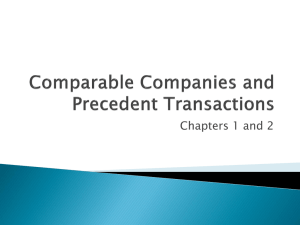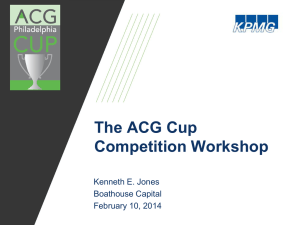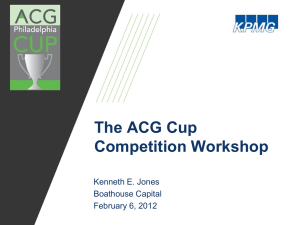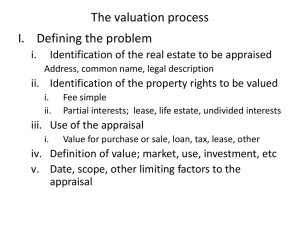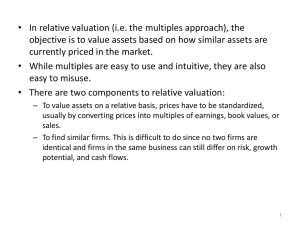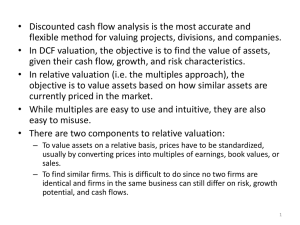Recruiting technical workshop slides
advertisement
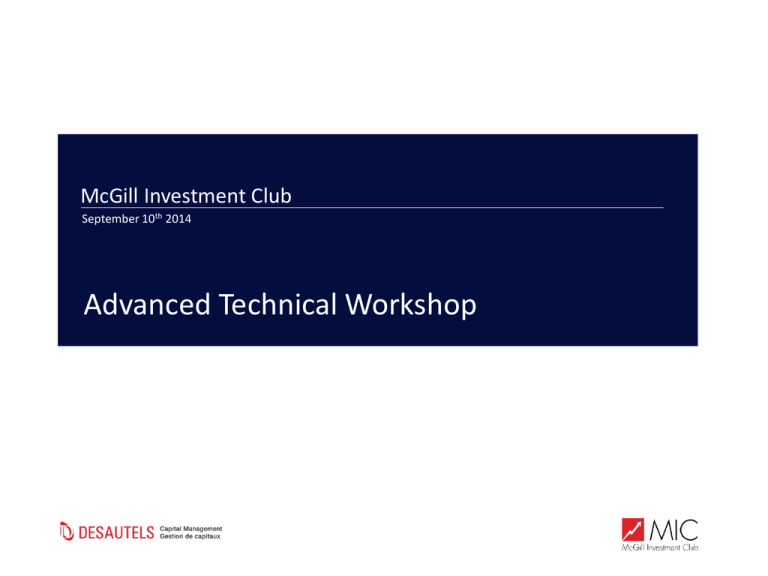
McGill Investment Club September 10th 2014 Advanced Technical Workshop Table of Contents Advanced Technical Workshop Section I: Refresher from Last Session a) DCF b) Comps c) Precedent Transactions Section II: Corporate Structure Questions Section III: Valuation Questions Section IV: Accounting Questions Section V: Stock Pitch Section VI: Q&A 2 Section I Refresher from Last Session Refresher Traditional Valuation Methodologies Discounted Cash Flow Precedent Transaction Analysis Comparable Trading Analysis • Value based on net present value of future cash flows (enterprise or equity cash flows) • Value based upon applying observed financial metrics from comparable past transactions • Value based upon applying observed current trading metrics of comparable, public companies 4 Section I a) Discounted Cash Flow Discount Cash Flow Principles “Value determined by calculating the present value of a stream of projected cash flows over a certain period and a terminal value” Projected after-tax unlevered free cash flows Forecast period should be long enough so that business reaches a steady state by the end of period and incorporates a cycle (if a cyclical industry) Typically 5 to 10 years Terminal value Value of perpetual cash flows following end of forecast Terminal year should best mirror company's normalized future steady state Discount rate Weighted average cost of capital (“WACC”) Depends on capital structure (typically weighted average cost of equity and debt) WACC should reflect optimal and sustainable capital structure and underlying estimate of business risk Enterprise Value • PV of cumulative cash flows to all claim holders Unlevered Free Cash Flow “UFCF” • + EBIT*(1-tax) • + Depreciation & Amortization • - Capital Expenditure • - ∆ in Working Capital Discounted Rate • Weighted Average Cost of Capital “WACC” 6 Discount Cash Flow Terminal Value “Determining the terminal value involves the application of one of the following going concern approaches” Practice • Comparable Trading / Transaction Multiple • • Perpetual Growth • • Considerations Based upon current trading multiples ~ multiples of EBITDA Based upon multiples paid in comparable company transactions • Single stage – constant growth perpetuity Unlevered Free Cash Flow * (1+ Perpetual Growth Rate) / (WACC – Perpetual Growth Rate) 2 stage – growth rate 1 for n years followed by growth rate 2 • • • • Industry or company considerations may make the current environment not comparable to the terminal year Implies a perpetual growth rate from the terminal point onward Ideal when company is in steady state Very sensitive to changes in inputs, especially perpetual growth rate assumptions Implies multiples as if the business was transacted in the terminal year 7 Discount Cash Flow Strengths & Limitations Strengths Limitations Based on well accepted corporate finance theory False perception attributed to sophisticated technique due to inherent subjectivity in forecast, terminal value and WACC Flexibility to handle different patterns of cash inflows and outflows Recognizes time value of money Demands extensive set of forecast data and related due diligence Allows explicit consideration of project risks Sensitive to long term growth assumptions Focuses on future operations Lacks external reference to reconcile valuation differences 8 Section I b) Comparable Company Analysis Comparable Company Analysis (‘’Comps’’) Overview What is comparable company analysis? Provides a market-based valuation perspective on comparable publicly traded companies It is based on publicly available information; reflects what the many independent investors that comprise the market think Implied valuation does not reflect premium for control or any synergy potential Effectiveness of this valuation method depends on the comparability of the companies selected and metrics used to compare the companies Comparable trading analysis: Key Valuation Metrics / Multiples Enterprise Value Equity Value • Revenues • Earnings • EBITDA • Levered Cash Flow • Unlevered Cash Flow • Book Value Multiples based on economics that all stakeholders are entitled to (debtholders and shareholders) Multiples based on economics that only shareholders are entitled to 10 Comparable Company Analysis Enterprise Value / EBITDA Less affected and easier to interpret when there are capital structure differences Permits the use of statistics less affected by accounting policy variations General Preference for Enterprise Value / EBITDA Multiples… More comprehensive – focuses on the business and not just the equity investor’s stake More flexible – can be modified to exclude non-core assets 11 Comparable Company Analysis Selecting Comparable Companies • • • Select the right peer group Focus on the appropriate financial metric and ratios: each sector utilizes a standard set of ratios/metrics Make the necessary adjustments to ensure comparability (non-recurring items, accounting policies, M&A activity) Value Drivers Relative Risk Profile Relative Growth Illustrative Considerations Strategic Positioning • • • Market / Product leadership Client-base & supply chain Technology & patent Size • • Market presence, operating “leverage” Good proxy for risk Profitability • • • Cost structure Margin analysis Consistency Capital Structure • Financial leverage Others • • • Quality of management Non-recurring items Different accounting practices Growth Profile • • • Sales, EBITDA, earnings Consistency of growth / volatility Growth potential 12 Comparable Company Analysis Strengths & Limitations Strengths Limitations Objective comparison reflecting all publicly available information on the overall sector and the individual companies Challenge of finding true “comparability” within peer groups • Growth / profitability expectations • Sector trends • Risk factors Often provides a reliable, useful first order approximation of value May be forward looking, and can also be backward looking Ease of understanding and application Requires fewer assumptions (e.g. Discount rates) Standard practice when valuing emerging companies, as forecasting cash flows is difficult • Very difficult to adjust for differences in underlying business of comps Company specific issues may limit analysis and effectiveness (e.g. limited liquidity) Other external factors may impact share price performance • Market sentiment, M&A activity in the sector and regulatory issues Analysis is focused on trailing date and on next 1-2 years, thus ignoring future performance and long-term issues Assumes market prices of comparable companies correctly reflect all available information 13 Section I c) Precedent Transaction Analysis Precedent Transactions Analysis Overview • Valuation based upon applying observed financial and operating metrics from comparable transactions • Provides useful information on valuation multiples that acq • Provides indication of private market value • Value of consideration that willing buyers and sellers are prepared to exchange in current economic environment • Many considerations discussed in Comparable Trading Analysis section apply, however three specific nuances to this methodology must be addressed Considerations Relevance • • • Comparability of precedent deals and the acquired companies Was the deal completed under comparable economic conditions Is the other consideration comparable (cash vs. stock)? Size • • Eliminate all deals that are too small or too large compared to the potential transaction Look at relative size of acquirer versus target Information • Only include deals where sufficient / reliable information is available Type of Deal • • • Private deals: if no public data is available, do not use in deal comparison Timing: the more recent the data, the more relevant the benchmark Auction / Interlopers: competition for the assets drives valuation up 15 Precedent Transactions Analysis Strengths & Limitations Strengths Limitations Based on public information Relevance deteriorates over time Reflects different premium at which transactions have been completed in the past (important to isolate impact of economic cycles) Important not to miss context for the premium paid in different transactions to avoid drawing misleading conclusions. Overview of potential interlopers based on historical behaviour and their strategic approach to M&A • Financial versus strategic investor; • Governance issues, commercial agreements, etc.; Ease of understanding and calculation • Asset competition driving up prices; and Commonly used yardstick / rule of thumb • Distressed sales. Important to distinguish what kind of assets were traded in order to achieve like-for-like comparisons. Market conditions at the time of a transaction can have substantial influence on valuation (ie. Sector consolidation) Challenge of true “comparability” 16 Section II Corporate Structure Questions Corporate Structure Enterprise Value Questions • Why do you need to add minority interest to obtain enterprise value? – – • A company has 100 shares at $10, 10 options with strike price of $5 and 10 options with strike price of $15. What are fully diluted shares? – – – • Whenever a company owns more than 50% of another company, it is required to report the financial performance of the whole company as part of its own performance To compare apples with apples, you must add minority interest to get to EV so that numerator and numerator both reflect 100% of the majority-owned subsidiary Treasury stock method: 10 in-the-money options will be exercised 10 shares issued With the $50 raised by the company, 5 shares are bought back 100 + 10 – 5 = 105 How to account for convertible bonds in the enterprise value formula? – – If in-the-money, additional dilution to equity holders If out-of-the-money, count the face value of the convertibles as part of debt 18 Corporate Structure Restructuring Questions • A company has had positive EBITDA for the last 10 years but recently went bankrupt. How could this happen? – – – • What options are available to a distressed company that can’t meet debt obligations? – – – – • Company cannot meet its interest obligations Large one-time event (e.g. litigation) Too much debt is maturing at the same time and company cannot repay principal Refinance and obtain new debt or equity Sell the company or a division (what are the drawbacks of this approach?) Restructure financial obligations with debt holders File for bankruptcy and restructure the firm What can the debt holders do to recover their principal? – – – – Lend additional capital in form of debt or equity Conditional financing (e.g. if the company reduces expenses, changes management, etc.) Sale Foreclosure 19 Corporate Structure Restructuring Questions • How do you calculate cost of debt for a distressed company? – – • You can sell your company by selling equity or assets, which one would you prefer? – – • Often the public debt of a distressed company will not be very liquid, therefore it will be difficult to use bond yields as a proxy Look at credit spreads (CCC or D companies) If you are the distressed seller, you prefer to sell your equity to get rid of liabilities and also because it is taxed higher for asset sales. However, you might get higher valuations by selling individual assets The buyer prefers to buy assets because he can pick and choose what is best How could a decline in a company’s share price cause it to go bankrupt? – Customers, vendors, suppliers, and lenders would be more reluctant to do business with the distressed company 20 Section III Valuation Questions Valuation Basic Valuation Methods • Which of the three methods yield the highest/lowest valuations? – – • How do you present valuation methodologies to a company? – • Valuation methods are all “triangulated” and presented on what is called a football field analysis, alongside 52-week trading range and research high and low valuation Why can’t you use an Equity Value / EBITDA multiple? – – • Typically, the precedent transaction valuation method yields the highest valuation given it incorporates a control premium The lowest valuation method is typically the Liquidation Value Because Equity Value does not take into account debt holders, but EBITDA incorporates interest (the return on debt holders) Multiples need to be sensitive to capital structure – if interest is included in the multiple, then so does the debt portion Why would someone want to use EV / EBIT multiples instead of EV / EBITDA? – Some companies like to adjust their depreciation and amortization policies to “adjust” earnings – therefore, EV/EBIT would be a more comparable metric amongst companies where these amounts significantly affect the multiples Valuation Alternative Valuation Methods • What is an LBO and why is used in practice? What is a good target? – – • How do you derive a liquidation value for a firm? – – – – • The acquisition of another company using a significant amount of borrowed money (bonds or loans) to meet the cost of acquisition The purpose of leveraged buyouts is to allow companies (mostly PE firms) to make large acquisitions without having to commit a lot of capital Cash: 100% A/R: 80% Inventory: 50% Goodwill: 0% When would you use sum of the parts and how does it work? – – Typically used for companies with different unrelated subsidiaries for which it would not be prudent to use a single DCF or simple comps (e.g. Samsung) Value every division separately (applying a multiple or building a DCF for each) and add up the values obtained 23 Valuation Typical Valuation Questions • How do you value a Cola distributing machine? – – • We have two companies with the same financial statements and operating segments, yet company A is trading at a higher multiple than company B. Why could this be the case? – – – – • Depending on the assumptions of the interviewer one might want to use any of the traditional or unconventional valuation methods we have discussed Not because it sounds weird that it cannot easily be valued Growth Management Intangibles Recent news Company A and B are the same, except A leases products instead of owning them. For which of the two would you pay a higher EV/EBITDA acquisition multiple? – – Company A: lease would show up in SG&A, reducing EBITDA Company B: depreciation charge does not show up in EBITDA, making it higher 24 Valuation Typical Valuation Questions • A company will be paying down debt in the coming years. How do we account for this in a DCF? – • For a mining company, would you expect higher multiples in cyclical upswings or downturns? – • Trick question. You should not, we do not look at CFF when generating UFCF During downturns because you expect commodity price to revert to mean in the future. Multiple is high because denominator is most likely to be very low at the moment How do you value a private company? – Technically you can still use a DCF but you how do you get to WACC? • – Estimate WACC from public comps but add in an illiquidity and perhaps size premium to reflect the risk of the private company To estimate the value of a private company that is about to do an IPO, no need to add illiquidity premium as the company will soon become public 25 Valuation Typical Valuation Questions • What are some industry specific multiples? – – – – • How do you value a company with negative EBITDA? Pre-revenue? – – • Oil and gas: EV / Production, EV / 2P Reserves Retail: EV / EBITDAR (R = Rent) Technology: EV / Unique visitors Financials: Price / Book Value Climb-up the ladder and use EV / Revenue Use creative multiples like EV / Clicks What variables impact an LBO model most? – – Purchase and exit multiples have the biggest impact on the returns of a model Amount of leverage (debt) used also has a significant impact, followed by operational characteristics such as revenue growth and EBITDA margins 26 Valuation Accretion/Dilution Questions • If a company with a higher P/E acquires a company with a lower P/E, is this an accretive or dilutive acquisition? – • ONLY IF the acquisition was financed 100% with equity or cash and IF the implied P/E with the acquisition premium is still lower can you say that the deal is accretive Rule of thumb for Accretion/Dilution – – – If the deal involves just cash and debt, you can sum up the interest expense for debt and the foregone interest on cash, then compare it against the seller’s Pre-Tax Income If it’s an all-stock deal you can compare P/E multiples But if the deal involves cash, stock, and debt, there’s no quick rule-of-thumb you can use but you can calculate it based on the average P/E of cash (1/interest earned on cash) and average P/E of debt (D/interest %) 27 Section IV Accounting Questions Accounting Classic Machine Question • On January 1st, company A buys a new machine for $100, financed with $50 in cash and $50 in debt. It will be depreciated on a straight line basis for 10 years. It will also contribute to revenue in the coming fiscal year by an additional $10 and COGS of $5. How will this affect all three financial statements at year end on December 31st? Assume a tax rate of 50% and interest rate of 10%. I/S Revenue COGS Depreciation EBIT Interest EBT Tax Net Income $ 10.00 $ (5.00) $ (10.00) $ (5.00) $ (5.00) $ (10.00) $ 5.00 $ (5.00) C/S Net Income $ (5.00) Depreciation $ 10.00 CFO $ 5.00 Debt CFF $ 50.00 $ 50.00 Machine CFI $ (100.00) $ (100.00) B/S Cash PPE Depreciation Assets $ (45.00) $ 100.00 $ (10.00) $ 45.00 Debt R.E. L + S.E. $ 50.00 $ (5.00) $ 45.00 Accounting Questions Typical Accounting Questions • How is GAAP/IFRS accounting different from tax accounting? – GAAP is accrual based but tax is cash based • – • Tax is only concerned with revenue/expenses in the current period and what income you owe GAAP uses straight-line depreciation whereas tax uses accelerated depreciation What are examples of non-recurring charges we need to add back to a company’s EBIT or EBITDA when looking at financial statements? – – – – – – – Restructuring charges Goodwill impairment Asset write-downs Bad debt expense Legal expenses Disaster expenses Changes in accounting procedures 30 Accounting Questions Typical Accounting Questions • What are NOL’s and how are they valued? – – – • Net operating losses: tax credit created when a company records losses. Can be carried back 3 years (2 in USA) and forward 20 years You should always carry back as much as possible today and exercise the credits as soon as possible in the future Value = NOLs that can be carried back today*Tax rate + PV(NOLs to be used in future)*Tax rate What is a depreciation waterfall? Depreciation Waterfall 2013 A Capital Expenditures Useful Life $100.00 $100.00 $100.00 $100.00 $100.00 $100.00 5 years 5 years 5 years 5 years 5 years 5 years Year 1 Year 2 Year 3 Year 4 Year 5 Year 6 $20.00 Depreciation $20.00 2014 E 2015 E 2016 E 2017 E $20.00 $20.00 $20.00 $20.00 $20.00 2018 E $20.00 $20.00 $20.00 $20.00 $20.00 $20.00 $20.00 $20.00 $20.00 $40.00 $60.00 $80.00 $100.00 $100.00 $20.00 $20.00 $20.00 $20.00 $20.00 31 Accounting Questions Typical Accounting Questions • Why would the D&A numbers from the I/S differ from the ones on the C/S? Which one should you use? – • When does goodwill impairment happen? – • This happens if D&A is embedded in other I/S line items. When this happens, you need to use the C/S number to arrive at EBITDA because you would be undercounting D&A When you reassess the value of the company you acquired (annual impairment test) and you find out it is worth significantly less. An example of this is tech companies that have been acquired before the tech bubble A company switches from LIFO to FIFO in an inflationary environment; how does it affect its statements? – Operating income and earnings will be overstated (lower COGS). Inventory will be higher as “cheaper” items will be sold first. CFO will be higher due to increased earnings, offset by a change in NWC 32 Section V Pitch a Stock Pitch a Stock Capital One Financial Best in class financial metrics Shift from growth to returning capital to shareholders Strong macro support Discounted valuation The market is discounting COF to its peers even though it has best in industry financial metrics, strong growth prospects in the consumer credit cards, and a shift in focus toward returning value to shareholders 34 Q&A Contact • Xavier Le Sieur – Bank of America, Merrill Lynch (Investment Banking) xavier.lesieur@mail.mcgill.ca I would be happy to help with: Cover Letter & Resume Review Mock Interviews General Finance Jobs available Reviewing Offers 36

